Leadership Report: Exploring Leadership Styles and Strategies
VerifiedAdded on 2023/01/17
|13
|3336
|23
Report
AI Summary
This report delves into the multifaceted world of leadership, exploring various leadership roles such as providing vision, establishing organizational structure, and being an effective role model. It examines the 'Great Man Theory' and the 'Blake-Mouton Leadership theory', highlighting their assumptions and criticisms. The report also discusses ethical principles like respect, service, community, justice, and honesty, and how they influence an individual's value system. Furthermore, it explores how effective leaders utilize the Balance Scorecard for strategic planning and performance management, outlining the four perspectives: financial, customer, internal process, and organizational capacity, along with the five principles for achieving breakthrough performance. Finally, the report analyzes various decision-making styles, including directive, conceptual, analytical, behavioral, and delegate models, offering a comprehensive overview of leadership strategies and practices.
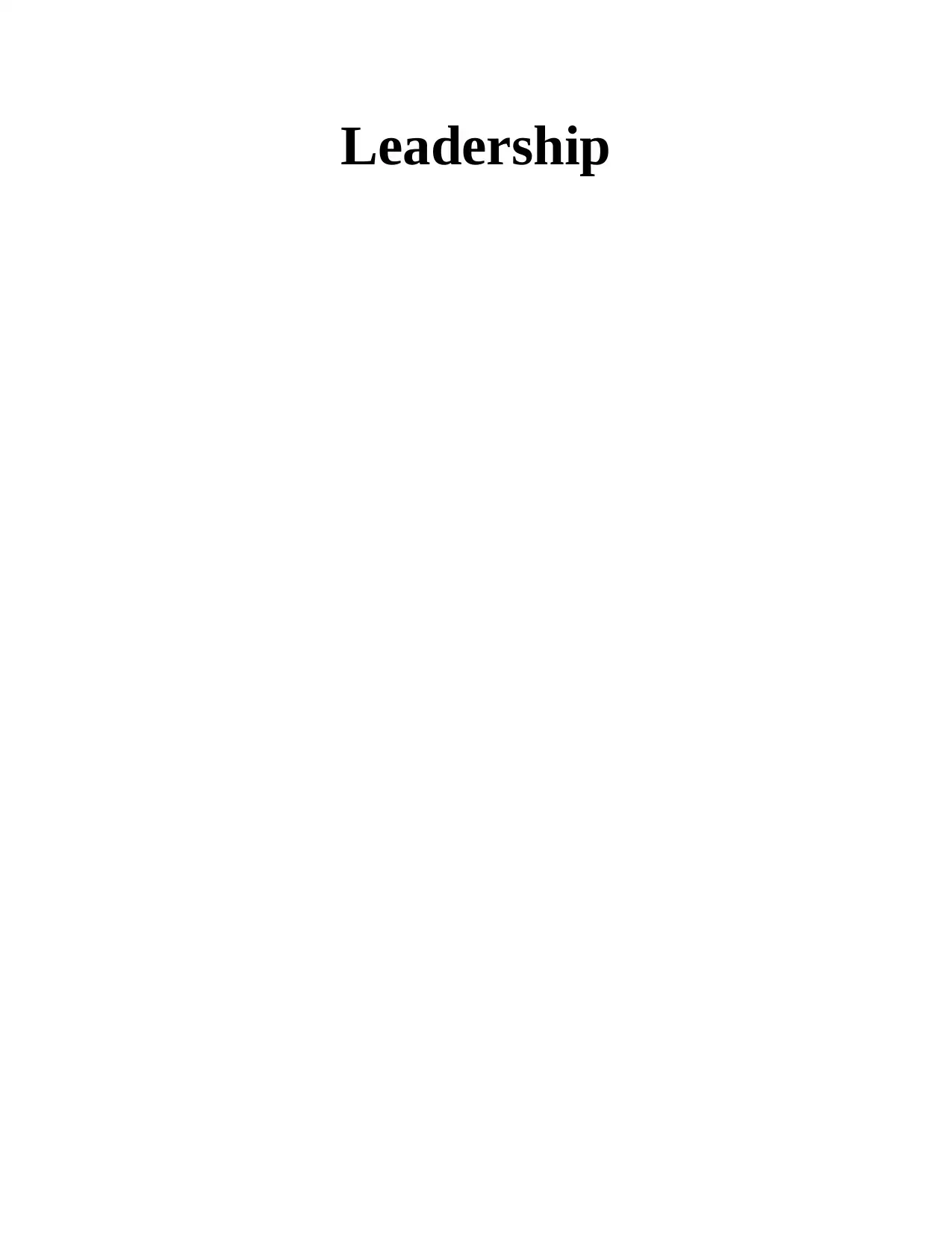
Leadership
Paraphrase This Document
Need a fresh take? Get an instant paraphrase of this document with our AI Paraphraser
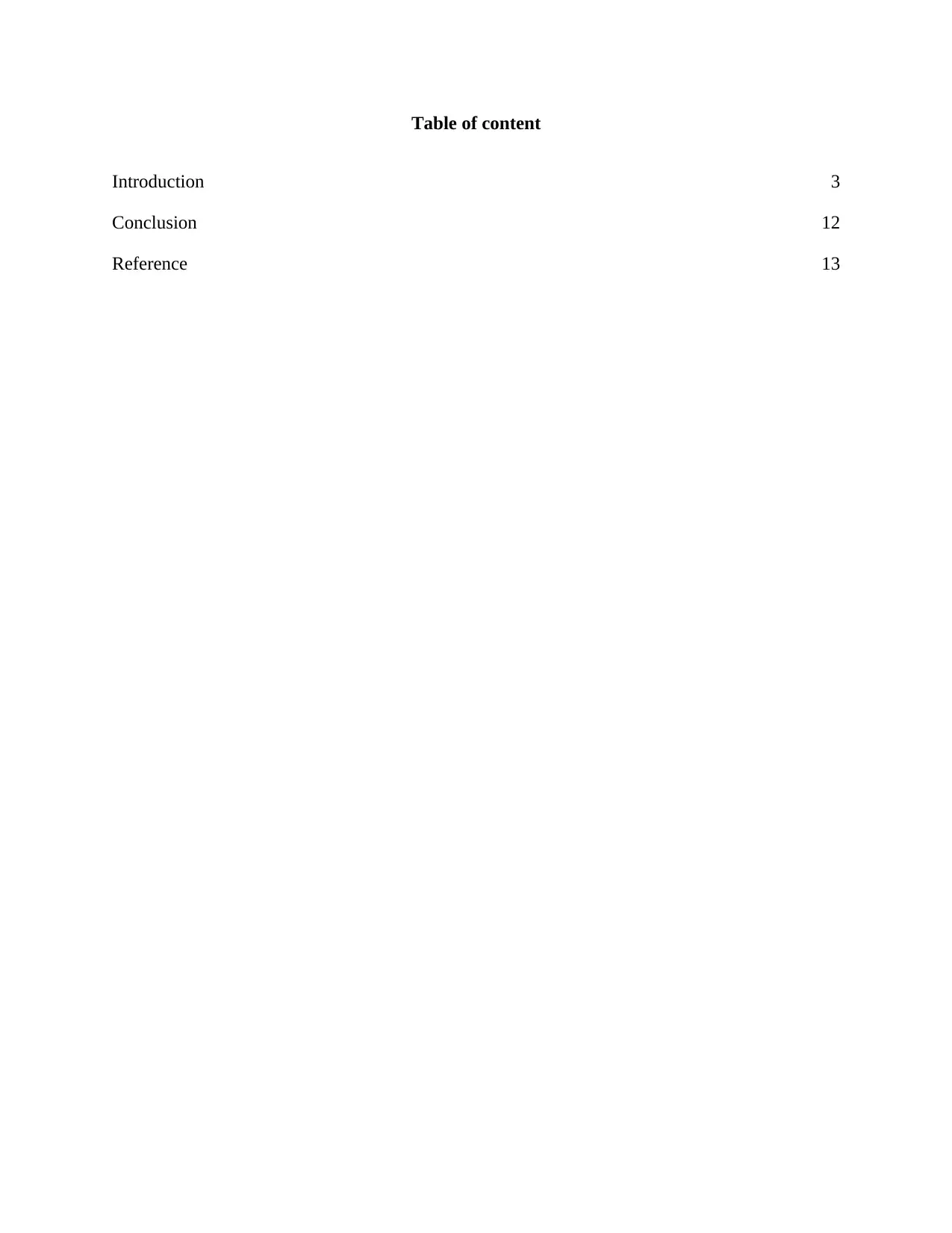
Table of content
Introduction 3
Conclusion 12
Reference 13
Introduction 3
Conclusion 12
Reference 13
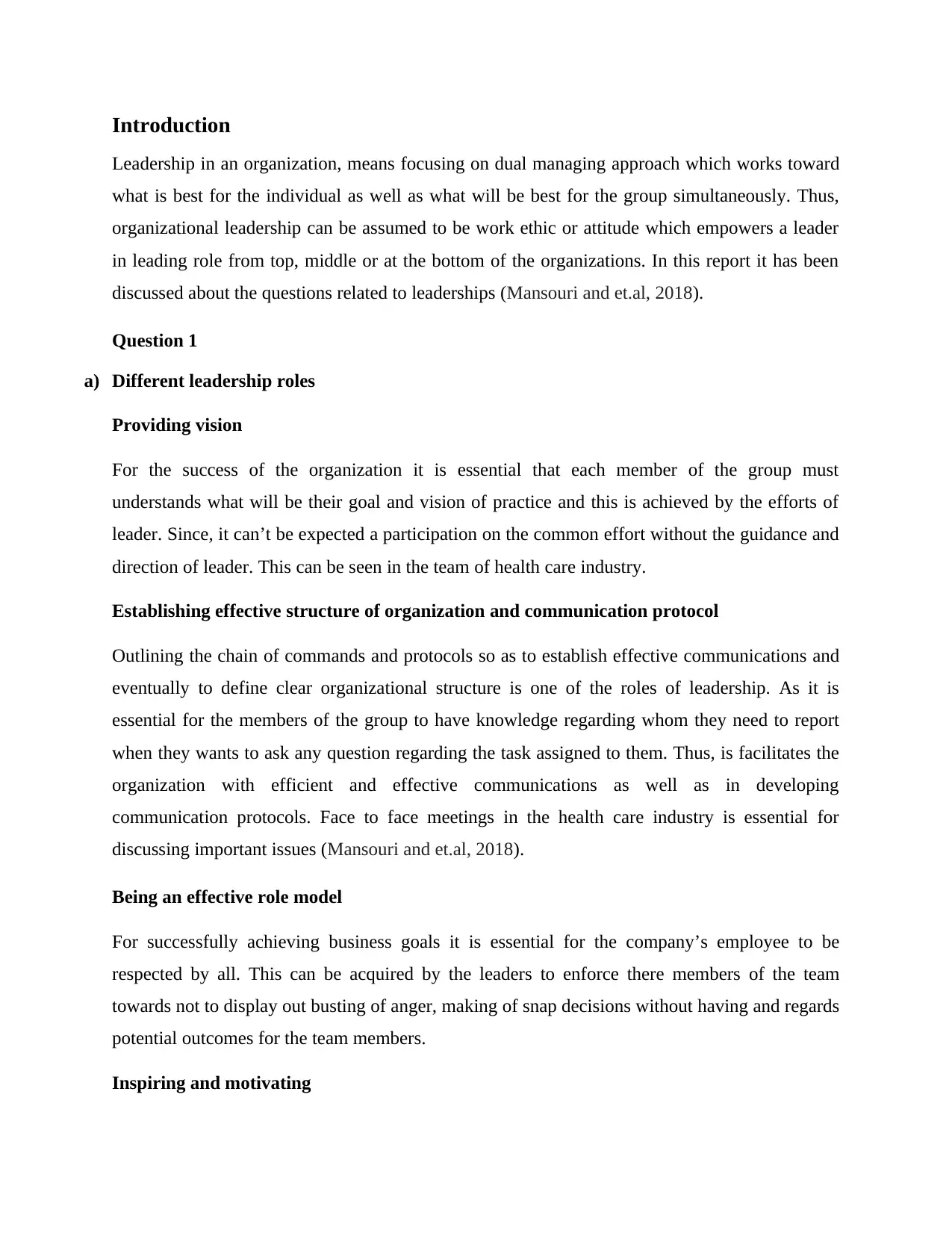
Introduction
Leadership in an organization, means focusing on dual managing approach which works toward
what is best for the individual as well as what will be best for the group simultaneously. Thus,
organizational leadership can be assumed to be work ethic or attitude which empowers a leader
in leading role from top, middle or at the bottom of the organizations. In this report it has been
discussed about the questions related to leaderships (Mansouri and et.al, 2018).
Question 1
a) Different leadership roles
Providing vision
For the success of the organization it is essential that each member of the group must
understands what will be their goal and vision of practice and this is achieved by the efforts of
leader. Since, it can’t be expected a participation on the common effort without the guidance and
direction of leader. This can be seen in the team of health care industry.
Establishing effective structure of organization and communication protocol
Outlining the chain of commands and protocols so as to establish effective communications and
eventually to define clear organizational structure is one of the roles of leadership. As it is
essential for the members of the group to have knowledge regarding whom they need to report
when they wants to ask any question regarding the task assigned to them. Thus, is facilitates the
organization with efficient and effective communications as well as in developing
communication protocols. Face to face meetings in the health care industry is essential for
discussing important issues (Mansouri and et.al, 2018).
Being an effective role model
For successfully achieving business goals it is essential for the company’s employee to be
respected by all. This can be acquired by the leaders to enforce there members of the team
towards not to display out busting of anger, making of snap decisions without having and regards
potential outcomes for the team members.
Inspiring and motivating
Leadership in an organization, means focusing on dual managing approach which works toward
what is best for the individual as well as what will be best for the group simultaneously. Thus,
organizational leadership can be assumed to be work ethic or attitude which empowers a leader
in leading role from top, middle or at the bottom of the organizations. In this report it has been
discussed about the questions related to leaderships (Mansouri and et.al, 2018).
Question 1
a) Different leadership roles
Providing vision
For the success of the organization it is essential that each member of the group must
understands what will be their goal and vision of practice and this is achieved by the efforts of
leader. Since, it can’t be expected a participation on the common effort without the guidance and
direction of leader. This can be seen in the team of health care industry.
Establishing effective structure of organization and communication protocol
Outlining the chain of commands and protocols so as to establish effective communications and
eventually to define clear organizational structure is one of the roles of leadership. As it is
essential for the members of the group to have knowledge regarding whom they need to report
when they wants to ask any question regarding the task assigned to them. Thus, is facilitates the
organization with efficient and effective communications as well as in developing
communication protocols. Face to face meetings in the health care industry is essential for
discussing important issues (Mansouri and et.al, 2018).
Being an effective role model
For successfully achieving business goals it is essential for the company’s employee to be
respected by all. This can be acquired by the leaders to enforce there members of the team
towards not to display out busting of anger, making of snap decisions without having and regards
potential outcomes for the team members.
Inspiring and motivating
⊘ This is a preview!⊘
Do you want full access?
Subscribe today to unlock all pages.

Trusted by 1+ million students worldwide
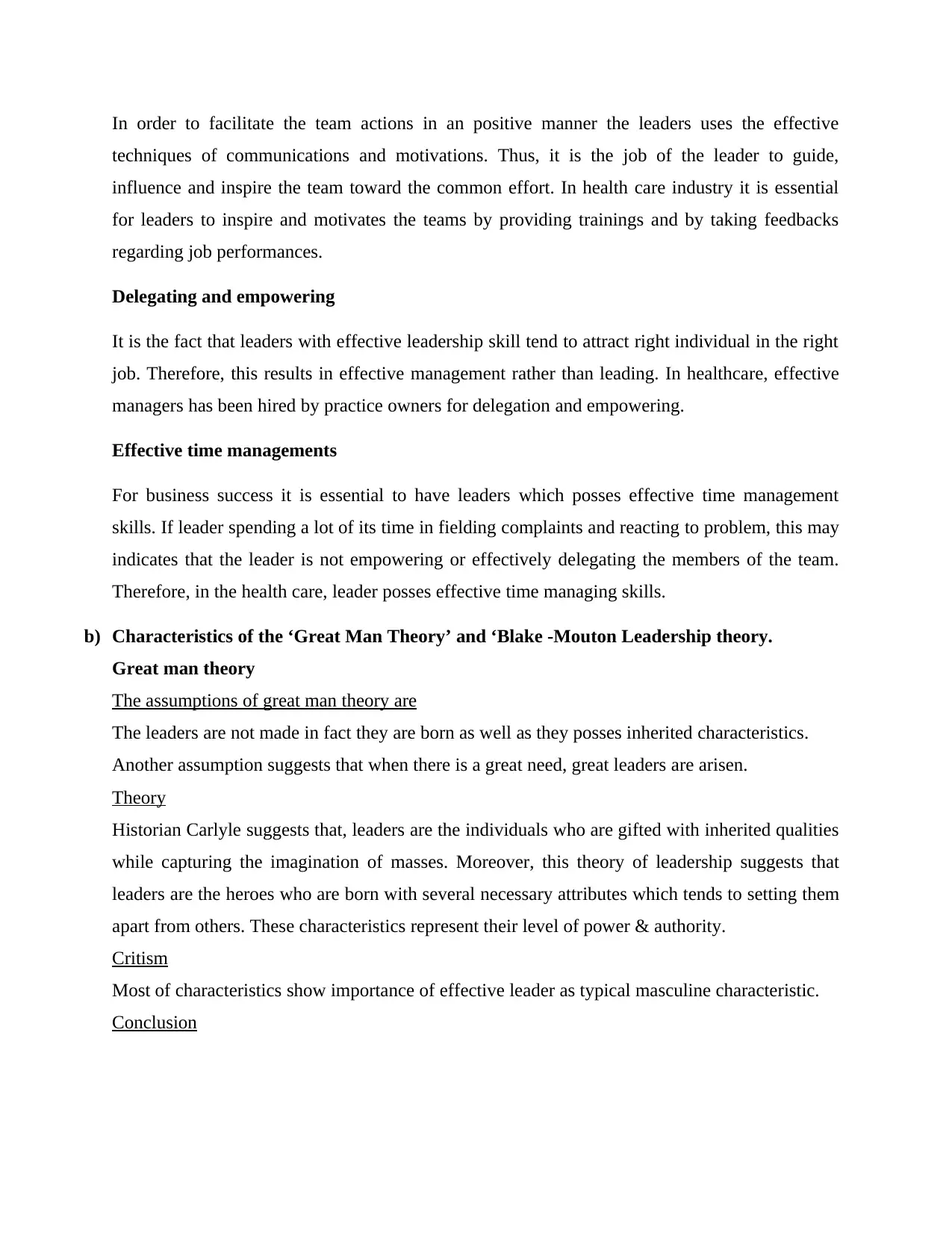
In order to facilitate the team actions in an positive manner the leaders uses the effective
techniques of communications and motivations. Thus, it is the job of the leader to guide,
influence and inspire the team toward the common effort. In health care industry it is essential
for leaders to inspire and motivates the teams by providing trainings and by taking feedbacks
regarding job performances.
Delegating and empowering
It is the fact that leaders with effective leadership skill tend to attract right individual in the right
job. Therefore, this results in effective management rather than leading. In healthcare, effective
managers has been hired by practice owners for delegation and empowering.
Effective time managements
For business success it is essential to have leaders which posses effective time management
skills. If leader spending a lot of its time in fielding complaints and reacting to problem, this may
indicates that the leader is not empowering or effectively delegating the members of the team.
Therefore, in the health care, leader posses effective time managing skills.
b) Characteristics of the ‘Great Man Theory’ and ‘Blake -Mouton Leadership theory.
Great man theory
The assumptions of great man theory are
The leaders are not made in fact they are born as well as they posses inherited characteristics.
Another assumption suggests that when there is a great need, great leaders are arisen.
Theory
Historian Carlyle suggests that, leaders are the individuals who are gifted with inherited qualities
while capturing the imagination of masses. Moreover, this theory of leadership suggests that
leaders are the heroes who are born with several necessary attributes which tends to setting them
apart from others. These characteristics represent their level of power & authority.
Critism
Most of characteristics show importance of effective leader as typical masculine characteristic.
Conclusion
techniques of communications and motivations. Thus, it is the job of the leader to guide,
influence and inspire the team toward the common effort. In health care industry it is essential
for leaders to inspire and motivates the teams by providing trainings and by taking feedbacks
regarding job performances.
Delegating and empowering
It is the fact that leaders with effective leadership skill tend to attract right individual in the right
job. Therefore, this results in effective management rather than leading. In healthcare, effective
managers has been hired by practice owners for delegation and empowering.
Effective time managements
For business success it is essential to have leaders which posses effective time management
skills. If leader spending a lot of its time in fielding complaints and reacting to problem, this may
indicates that the leader is not empowering or effectively delegating the members of the team.
Therefore, in the health care, leader posses effective time managing skills.
b) Characteristics of the ‘Great Man Theory’ and ‘Blake -Mouton Leadership theory.
Great man theory
The assumptions of great man theory are
The leaders are not made in fact they are born as well as they posses inherited characteristics.
Another assumption suggests that when there is a great need, great leaders are arisen.
Theory
Historian Carlyle suggests that, leaders are the individuals who are gifted with inherited qualities
while capturing the imagination of masses. Moreover, this theory of leadership suggests that
leaders are the heroes who are born with several necessary attributes which tends to setting them
apart from others. These characteristics represent their level of power & authority.
Critism
Most of characteristics show importance of effective leader as typical masculine characteristic.
Conclusion
Paraphrase This Document
Need a fresh take? Get an instant paraphrase of this document with our AI Paraphraser
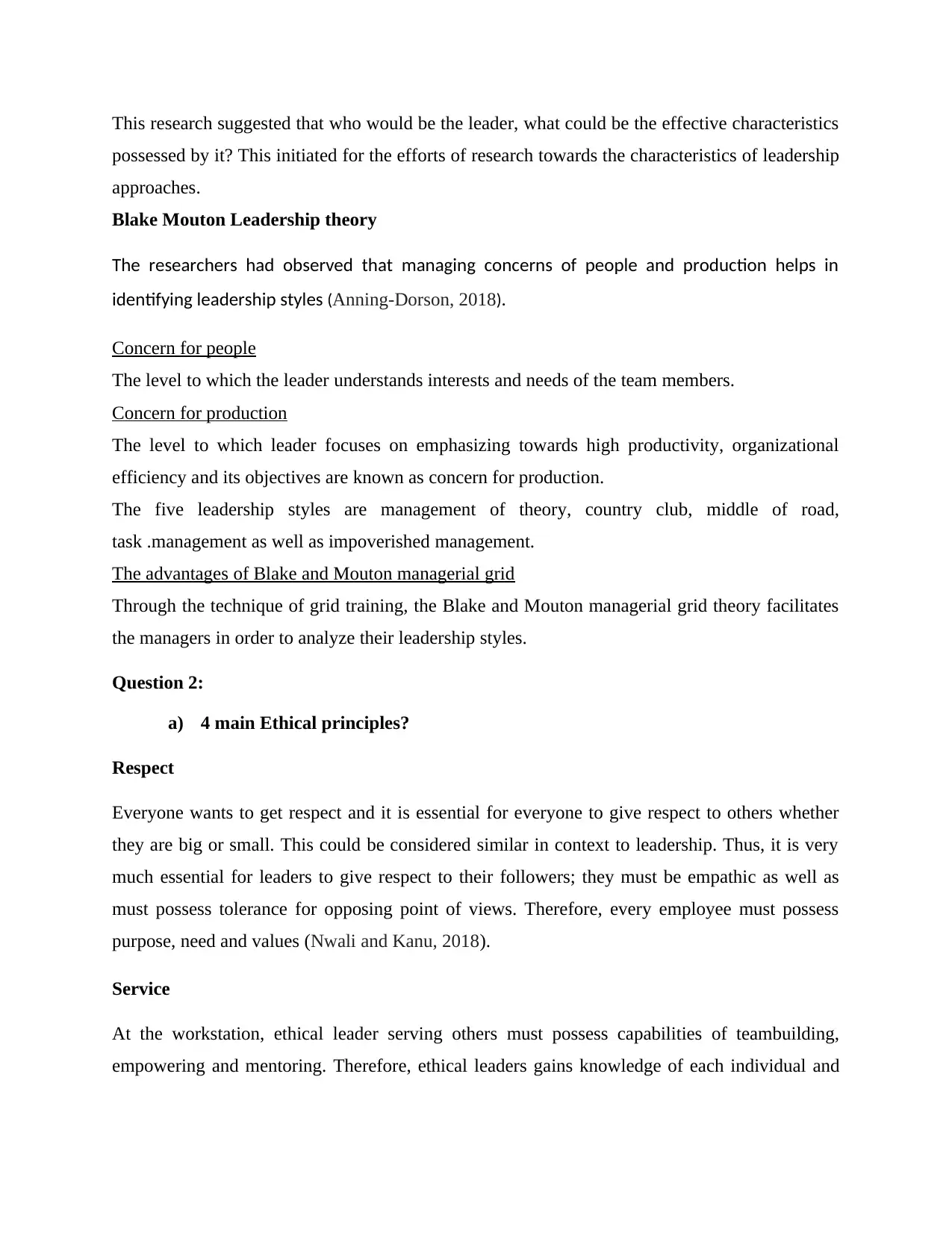
This research suggested that who would be the leader, what could be the effective characteristics
possessed by it? This initiated for the efforts of research towards the characteristics of leadership
approaches.
Blake Mouton Leadership theory
The researchers had observed that managing concerns of people and production helps in
identifying leadership styles (Anning-Dorson, 2018).
Concern for people
The level to which the leader understands interests and needs of the team members.
Concern for production
The level to which leader focuses on emphasizing towards high productivity, organizational
efficiency and its objectives are known as concern for production.
The five leadership styles are management of theory, country club, middle of road,
task .management as well as impoverished management.
The advantages of Blake and Mouton managerial grid
Through the technique of grid training, the Blake and Mouton managerial grid theory facilitates
the managers in order to analyze their leadership styles.
Question 2:
a) 4 main Ethical principles?
Respect
Everyone wants to get respect and it is essential for everyone to give respect to others whether
they are big or small. This could be considered similar in context to leadership. Thus, it is very
much essential for leaders to give respect to their followers; they must be empathic as well as
must possess tolerance for opposing point of views. Therefore, every employee must possess
purpose, need and values (Nwali and Kanu, 2018).
Service
At the workstation, ethical leader serving others must possess capabilities of teambuilding,
empowering and mentoring. Therefore, ethical leaders gains knowledge of each individual and
possessed by it? This initiated for the efforts of research towards the characteristics of leadership
approaches.
Blake Mouton Leadership theory
The researchers had observed that managing concerns of people and production helps in
identifying leadership styles (Anning-Dorson, 2018).
Concern for people
The level to which the leader understands interests and needs of the team members.
Concern for production
The level to which leader focuses on emphasizing towards high productivity, organizational
efficiency and its objectives are known as concern for production.
The five leadership styles are management of theory, country club, middle of road,
task .management as well as impoverished management.
The advantages of Blake and Mouton managerial grid
Through the technique of grid training, the Blake and Mouton managerial grid theory facilitates
the managers in order to analyze their leadership styles.
Question 2:
a) 4 main Ethical principles?
Respect
Everyone wants to get respect and it is essential for everyone to give respect to others whether
they are big or small. This could be considered similar in context to leadership. Thus, it is very
much essential for leaders to give respect to their followers; they must be empathic as well as
must possess tolerance for opposing point of views. Therefore, every employee must possess
purpose, need and values (Nwali and Kanu, 2018).
Service
At the workstation, ethical leader serving others must possess capabilities of teambuilding,
empowering and mentoring. Therefore, ethical leaders gains knowledge of each individual and
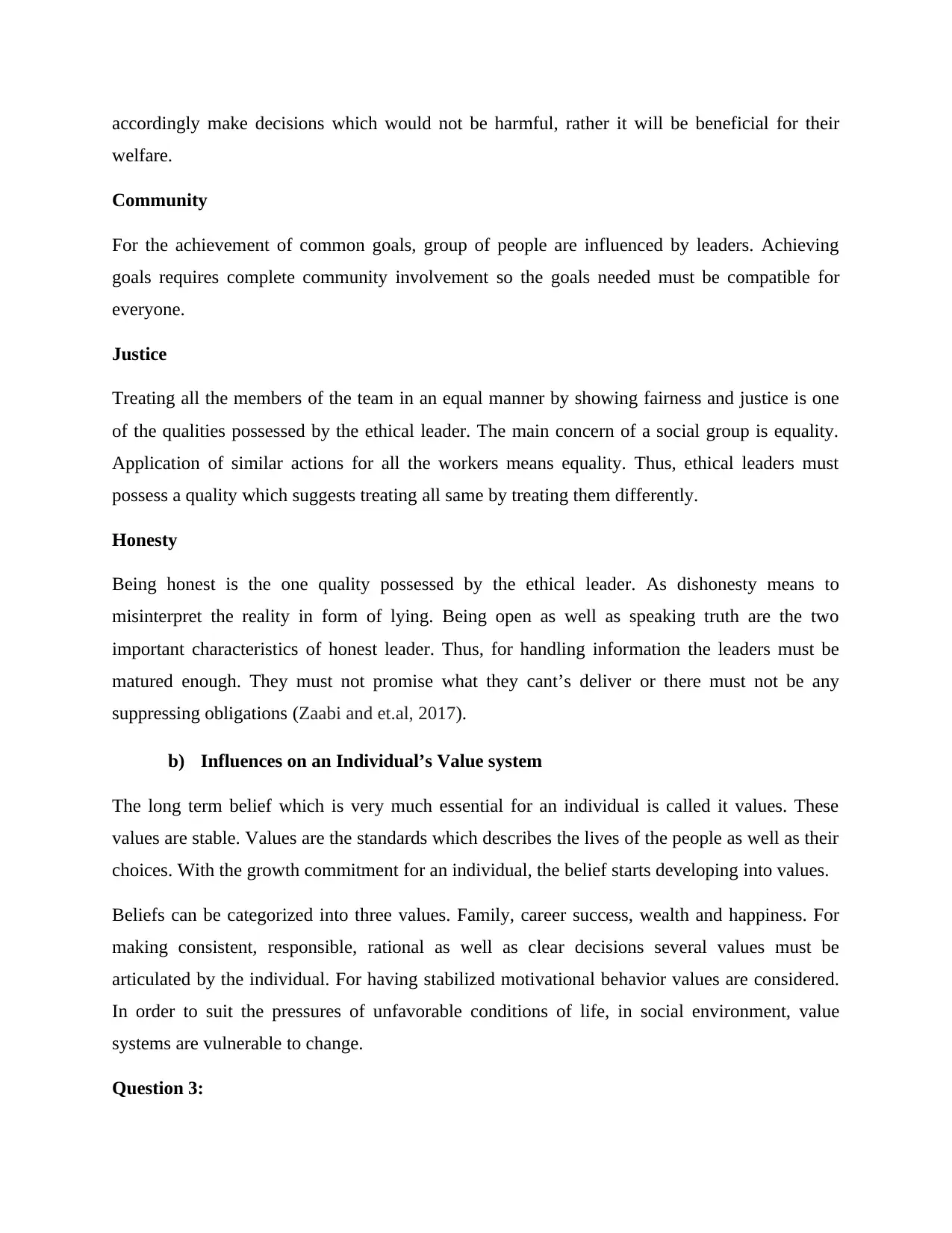
accordingly make decisions which would not be harmful, rather it will be beneficial for their
welfare.
Community
For the achievement of common goals, group of people are influenced by leaders. Achieving
goals requires complete community involvement so the goals needed must be compatible for
everyone.
Justice
Treating all the members of the team in an equal manner by showing fairness and justice is one
of the qualities possessed by the ethical leader. The main concern of a social group is equality.
Application of similar actions for all the workers means equality. Thus, ethical leaders must
possess a quality which suggests treating all same by treating them differently.
Honesty
Being honest is the one quality possessed by the ethical leader. As dishonesty means to
misinterpret the reality in form of lying. Being open as well as speaking truth are the two
important characteristics of honest leader. Thus, for handling information the leaders must be
matured enough. They must not promise what they cant’s deliver or there must not be any
suppressing obligations (Zaabi and et.al, 2017).
b) Influences on an Individual’s Value system
The long term belief which is very much essential for an individual is called it values. These
values are stable. Values are the standards which describes the lives of the people as well as their
choices. With the growth commitment for an individual, the belief starts developing into values.
Beliefs can be categorized into three values. Family, career success, wealth and happiness. For
making consistent, responsible, rational as well as clear decisions several values must be
articulated by the individual. For having stabilized motivational behavior values are considered.
In order to suit the pressures of unfavorable conditions of life, in social environment, value
systems are vulnerable to change.
Question 3:
welfare.
Community
For the achievement of common goals, group of people are influenced by leaders. Achieving
goals requires complete community involvement so the goals needed must be compatible for
everyone.
Justice
Treating all the members of the team in an equal manner by showing fairness and justice is one
of the qualities possessed by the ethical leader. The main concern of a social group is equality.
Application of similar actions for all the workers means equality. Thus, ethical leaders must
possess a quality which suggests treating all same by treating them differently.
Honesty
Being honest is the one quality possessed by the ethical leader. As dishonesty means to
misinterpret the reality in form of lying. Being open as well as speaking truth are the two
important characteristics of honest leader. Thus, for handling information the leaders must be
matured enough. They must not promise what they cant’s deliver or there must not be any
suppressing obligations (Zaabi and et.al, 2017).
b) Influences on an Individual’s Value system
The long term belief which is very much essential for an individual is called it values. These
values are stable. Values are the standards which describes the lives of the people as well as their
choices. With the growth commitment for an individual, the belief starts developing into values.
Beliefs can be categorized into three values. Family, career success, wealth and happiness. For
making consistent, responsible, rational as well as clear decisions several values must be
articulated by the individual. For having stabilized motivational behavior values are considered.
In order to suit the pressures of unfavorable conditions of life, in social environment, value
systems are vulnerable to change.
Question 3:
⊘ This is a preview!⊘
Do you want full access?
Subscribe today to unlock all pages.

Trusted by 1+ million students worldwide
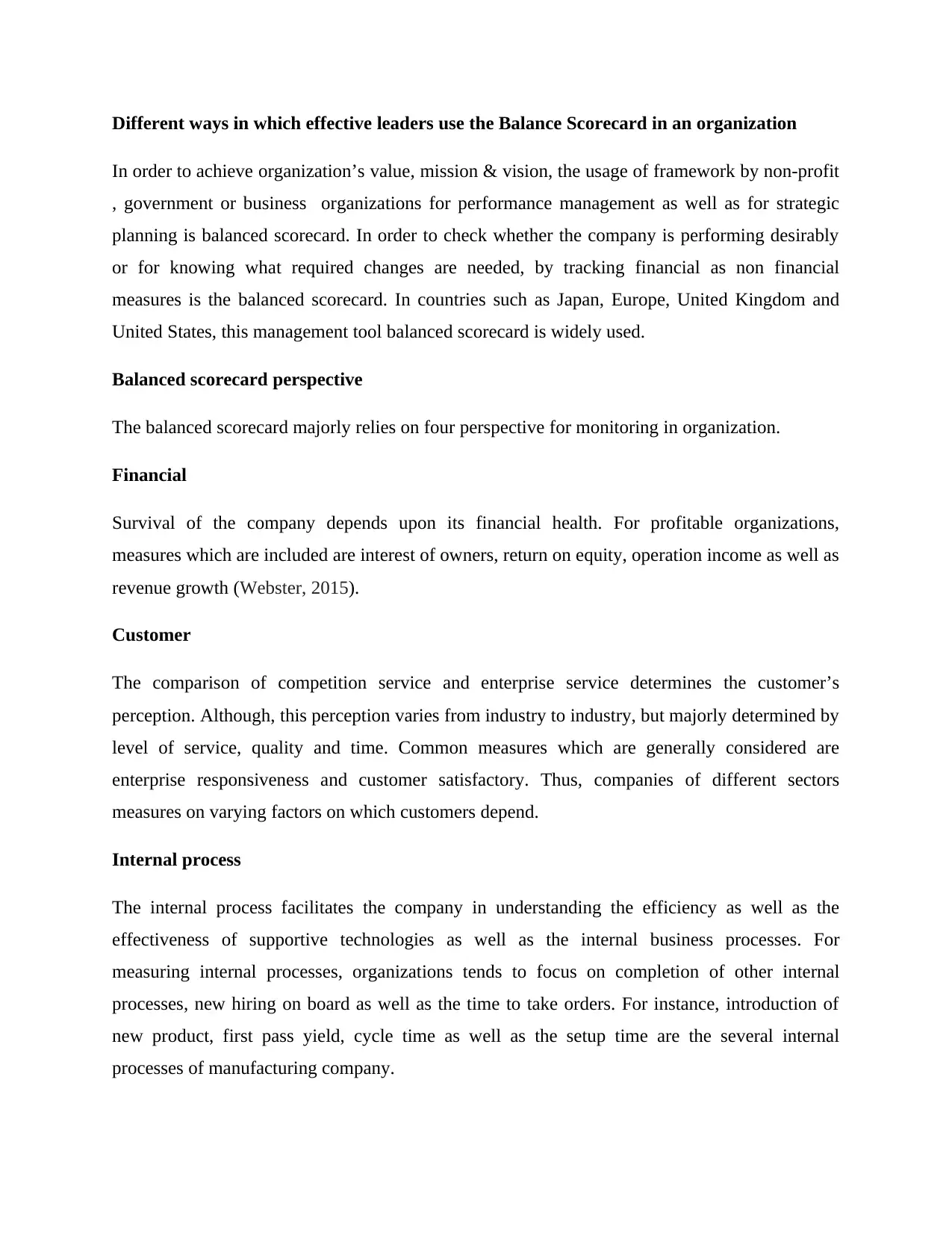
Different ways in which effective leaders use the Balance Scorecard in an organization
In order to achieve organization’s value, mission & vision, the usage of framework by non-profit
, government or business organizations for performance management as well as for strategic
planning is balanced scorecard. In order to check whether the company is performing desirably
or for knowing what required changes are needed, by tracking financial as non financial
measures is the balanced scorecard. In countries such as Japan, Europe, United Kingdom and
United States, this management tool balanced scorecard is widely used.
Balanced scorecard perspective
The balanced scorecard majorly relies on four perspective for monitoring in organization.
Financial
Survival of the company depends upon its financial health. For profitable organizations,
measures which are included are interest of owners, return on equity, operation income as well as
revenue growth (Webster, 2015).
Customer
The comparison of competition service and enterprise service determines the customer’s
perception. Although, this perception varies from industry to industry, but majorly determined by
level of service, quality and time. Common measures which are generally considered are
enterprise responsiveness and customer satisfactory. Thus, companies of different sectors
measures on varying factors on which customers depend.
Internal process
The internal process facilitates the company in understanding the efficiency as well as the
effectiveness of supportive technologies as well as the internal business processes. For
measuring internal processes, organizations tends to focus on completion of other internal
processes, new hiring on board as well as the time to take orders. For instance, introduction of
new product, first pass yield, cycle time as well as the setup time are the several internal
processes of manufacturing company.
In order to achieve organization’s value, mission & vision, the usage of framework by non-profit
, government or business organizations for performance management as well as for strategic
planning is balanced scorecard. In order to check whether the company is performing desirably
or for knowing what required changes are needed, by tracking financial as non financial
measures is the balanced scorecard. In countries such as Japan, Europe, United Kingdom and
United States, this management tool balanced scorecard is widely used.
Balanced scorecard perspective
The balanced scorecard majorly relies on four perspective for monitoring in organization.
Financial
Survival of the company depends upon its financial health. For profitable organizations,
measures which are included are interest of owners, return on equity, operation income as well as
revenue growth (Webster, 2015).
Customer
The comparison of competition service and enterprise service determines the customer’s
perception. Although, this perception varies from industry to industry, but majorly determined by
level of service, quality and time. Common measures which are generally considered are
enterprise responsiveness and customer satisfactory. Thus, companies of different sectors
measures on varying factors on which customers depend.
Internal process
The internal process facilitates the company in understanding the efficiency as well as the
effectiveness of supportive technologies as well as the internal business processes. For
measuring internal processes, organizations tends to focus on completion of other internal
processes, new hiring on board as well as the time to take orders. For instance, introduction of
new product, first pass yield, cycle time as well as the setup time are the several internal
processes of manufacturing company.
Paraphrase This Document
Need a fresh take? Get an instant paraphrase of this document with our AI Paraphraser
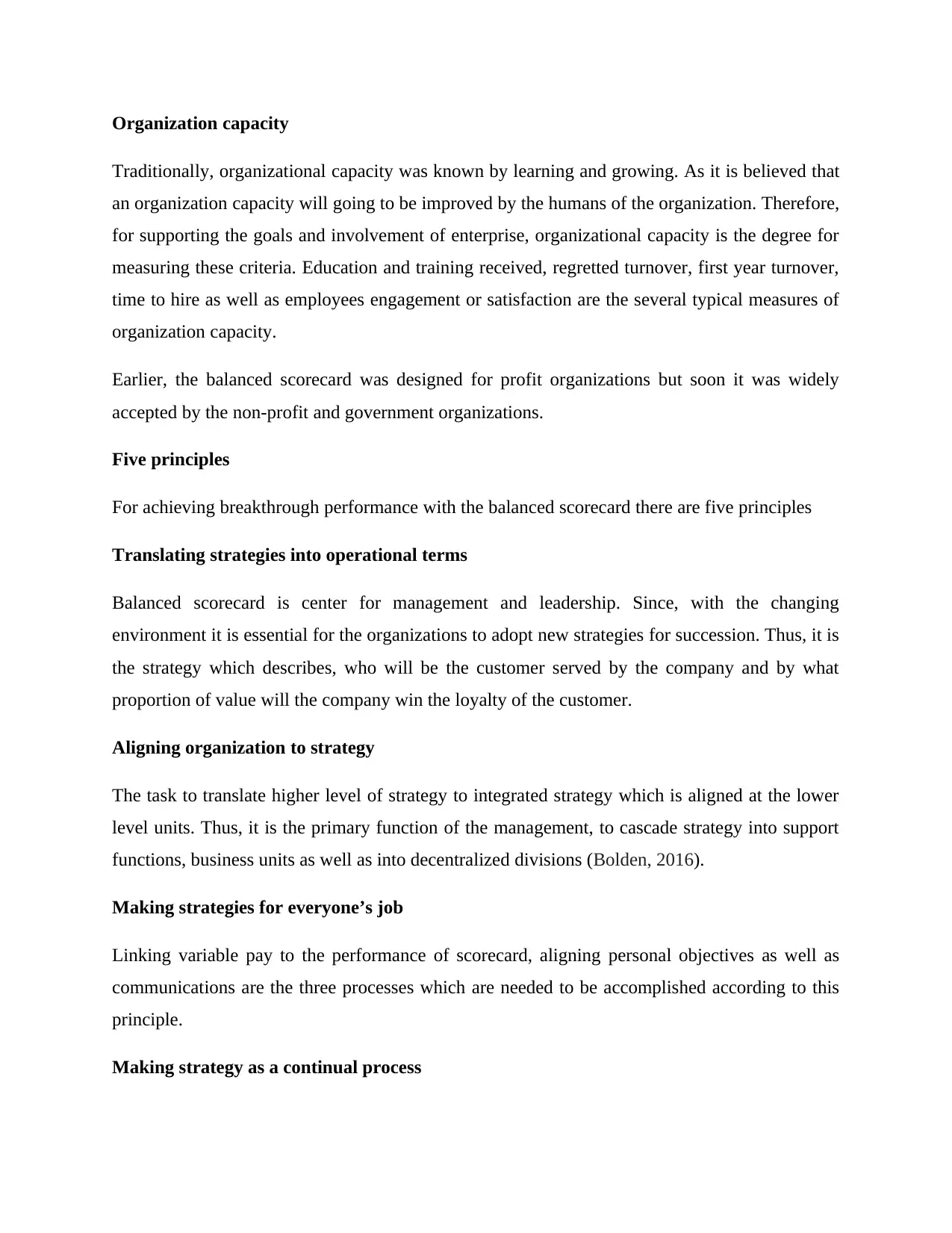
Organization capacity
Traditionally, organizational capacity was known by learning and growing. As it is believed that
an organization capacity will going to be improved by the humans of the organization. Therefore,
for supporting the goals and involvement of enterprise, organizational capacity is the degree for
measuring these criteria. Education and training received, regretted turnover, first year turnover,
time to hire as well as employees engagement or satisfaction are the several typical measures of
organization capacity.
Earlier, the balanced scorecard was designed for profit organizations but soon it was widely
accepted by the non-profit and government organizations.
Five principles
For achieving breakthrough performance with the balanced scorecard there are five principles
Translating strategies into operational terms
Balanced scorecard is center for management and leadership. Since, with the changing
environment it is essential for the organizations to adopt new strategies for succession. Thus, it is
the strategy which describes, who will be the customer served by the company and by what
proportion of value will the company win the loyalty of the customer.
Aligning organization to strategy
The task to translate higher level of strategy to integrated strategy which is aligned at the lower
level units. Thus, it is the primary function of the management, to cascade strategy into support
functions, business units as well as into decentralized divisions (Bolden, 2016).
Making strategies for everyone’s job
Linking variable pay to the performance of scorecard, aligning personal objectives as well as
communications are the three processes which are needed to be accomplished according to this
principle.
Making strategy as a continual process
Traditionally, organizational capacity was known by learning and growing. As it is believed that
an organization capacity will going to be improved by the humans of the organization. Therefore,
for supporting the goals and involvement of enterprise, organizational capacity is the degree for
measuring these criteria. Education and training received, regretted turnover, first year turnover,
time to hire as well as employees engagement or satisfaction are the several typical measures of
organization capacity.
Earlier, the balanced scorecard was designed for profit organizations but soon it was widely
accepted by the non-profit and government organizations.
Five principles
For achieving breakthrough performance with the balanced scorecard there are five principles
Translating strategies into operational terms
Balanced scorecard is center for management and leadership. Since, with the changing
environment it is essential for the organizations to adopt new strategies for succession. Thus, it is
the strategy which describes, who will be the customer served by the company and by what
proportion of value will the company win the loyalty of the customer.
Aligning organization to strategy
The task to translate higher level of strategy to integrated strategy which is aligned at the lower
level units. Thus, it is the primary function of the management, to cascade strategy into support
functions, business units as well as into decentralized divisions (Bolden, 2016).
Making strategies for everyone’s job
Linking variable pay to the performance of scorecard, aligning personal objectives as well as
communications are the three processes which are needed to be accomplished according to this
principle.
Making strategy as a continual process
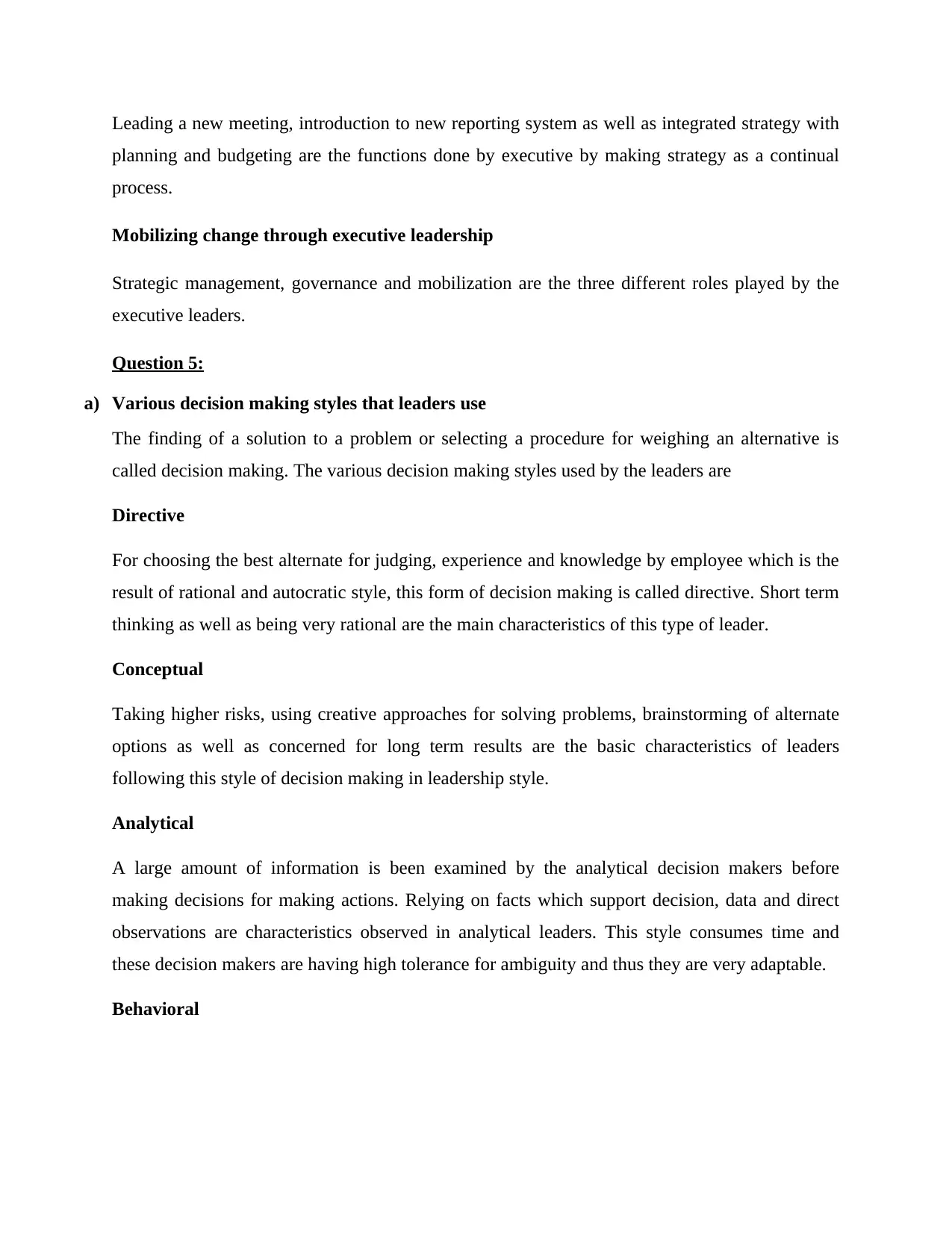
Leading a new meeting, introduction to new reporting system as well as integrated strategy with
planning and budgeting are the functions done by executive by making strategy as a continual
process.
Mobilizing change through executive leadership
Strategic management, governance and mobilization are the three different roles played by the
executive leaders.
Question 5:
a) Various decision making styles that leaders use
The finding of a solution to a problem or selecting a procedure for weighing an alternative is
called decision making. The various decision making styles used by the leaders are
Directive
For choosing the best alternate for judging, experience and knowledge by employee which is the
result of rational and autocratic style, this form of decision making is called directive. Short term
thinking as well as being very rational are the main characteristics of this type of leader.
Conceptual
Taking higher risks, using creative approaches for solving problems, brainstorming of alternate
options as well as concerned for long term results are the basic characteristics of leaders
following this style of decision making in leadership style.
Analytical
A large amount of information is been examined by the analytical decision makers before
making decisions for making actions. Relying on facts which support decision, data and direct
observations are characteristics observed in analytical leaders. This style consumes time and
these decision makers are having high tolerance for ambiguity and thus they are very adaptable.
Behavioral
planning and budgeting are the functions done by executive by making strategy as a continual
process.
Mobilizing change through executive leadership
Strategic management, governance and mobilization are the three different roles played by the
executive leaders.
Question 5:
a) Various decision making styles that leaders use
The finding of a solution to a problem or selecting a procedure for weighing an alternative is
called decision making. The various decision making styles used by the leaders are
Directive
For choosing the best alternate for judging, experience and knowledge by employee which is the
result of rational and autocratic style, this form of decision making is called directive. Short term
thinking as well as being very rational are the main characteristics of this type of leader.
Conceptual
Taking higher risks, using creative approaches for solving problems, brainstorming of alternate
options as well as concerned for long term results are the basic characteristics of leaders
following this style of decision making in leadership style.
Analytical
A large amount of information is been examined by the analytical decision makers before
making decisions for making actions. Relying on facts which support decision, data and direct
observations are characteristics observed in analytical leaders. This style consumes time and
these decision makers are having high tolerance for ambiguity and thus they are very adaptable.
Behavioral
⊘ This is a preview!⊘
Do you want full access?
Subscribe today to unlock all pages.

Trusted by 1+ million students worldwide
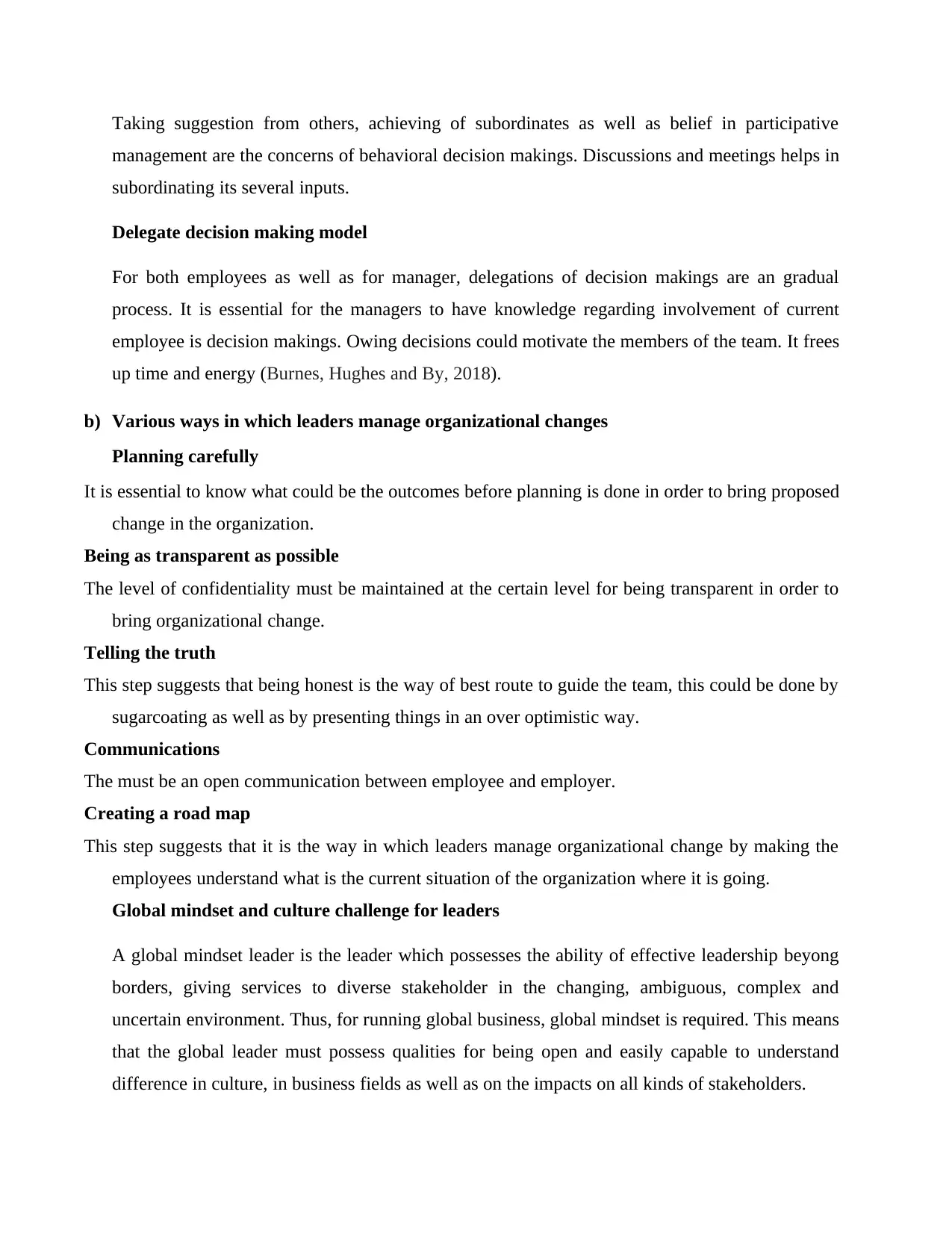
Taking suggestion from others, achieving of subordinates as well as belief in participative
management are the concerns of behavioral decision makings. Discussions and meetings helps in
subordinating its several inputs.
Delegate decision making model
For both employees as well as for manager, delegations of decision makings are an gradual
process. It is essential for the managers to have knowledge regarding involvement of current
employee is decision makings. Owing decisions could motivate the members of the team. It frees
up time and energy (Burnes, Hughes and By, 2018).
b) Various ways in which leaders manage organizational changes
Planning carefully
It is essential to know what could be the outcomes before planning is done in order to bring proposed
change in the organization.
Being as transparent as possible
The level of confidentiality must be maintained at the certain level for being transparent in order to
bring organizational change.
Telling the truth
This step suggests that being honest is the way of best route to guide the team, this could be done by
sugarcoating as well as by presenting things in an over optimistic way.
Communications
The must be an open communication between employee and employer.
Creating a road map
This step suggests that it is the way in which leaders manage organizational change by making the
employees understand what is the current situation of the organization where it is going.
Global mindset and culture challenge for leaders
A global mindset leader is the leader which possesses the ability of effective leadership beyong
borders, giving services to diverse stakeholder in the changing, ambiguous, complex and
uncertain environment. Thus, for running global business, global mindset is required. This means
that the global leader must possess qualities for being open and easily capable to understand
difference in culture, in business fields as well as on the impacts on all kinds of stakeholders.
management are the concerns of behavioral decision makings. Discussions and meetings helps in
subordinating its several inputs.
Delegate decision making model
For both employees as well as for manager, delegations of decision makings are an gradual
process. It is essential for the managers to have knowledge regarding involvement of current
employee is decision makings. Owing decisions could motivate the members of the team. It frees
up time and energy (Burnes, Hughes and By, 2018).
b) Various ways in which leaders manage organizational changes
Planning carefully
It is essential to know what could be the outcomes before planning is done in order to bring proposed
change in the organization.
Being as transparent as possible
The level of confidentiality must be maintained at the certain level for being transparent in order to
bring organizational change.
Telling the truth
This step suggests that being honest is the way of best route to guide the team, this could be done by
sugarcoating as well as by presenting things in an over optimistic way.
Communications
The must be an open communication between employee and employer.
Creating a road map
This step suggests that it is the way in which leaders manage organizational change by making the
employees understand what is the current situation of the organization where it is going.
Global mindset and culture challenge for leaders
A global mindset leader is the leader which possesses the ability of effective leadership beyong
borders, giving services to diverse stakeholder in the changing, ambiguous, complex and
uncertain environment. Thus, for running global business, global mindset is required. This means
that the global leader must possess qualities for being open and easily capable to understand
difference in culture, in business fields as well as on the impacts on all kinds of stakeholders.
Paraphrase This Document
Need a fresh take? Get an instant paraphrase of this document with our AI Paraphraser
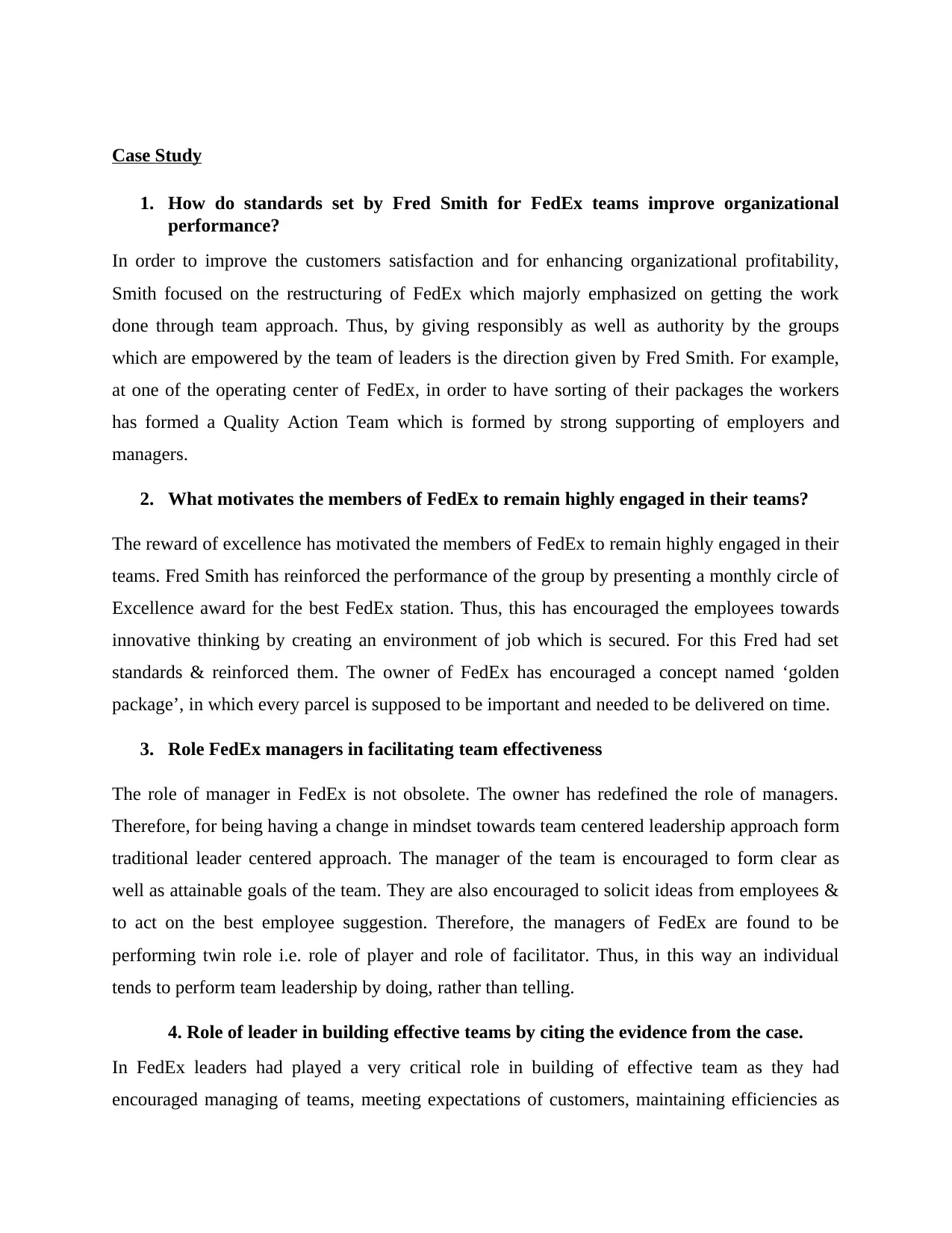
Case Study
1. How do standards set by Fred Smith for FedEx teams improve organizational
performance?
In order to improve the customers satisfaction and for enhancing organizational profitability,
Smith focused on the restructuring of FedEx which majorly emphasized on getting the work
done through team approach. Thus, by giving responsibly as well as authority by the groups
which are empowered by the team of leaders is the direction given by Fred Smith. For example,
at one of the operating center of FedEx, in order to have sorting of their packages the workers
has formed a Quality Action Team which is formed by strong supporting of employers and
managers.
2. What motivates the members of FedEx to remain highly engaged in their teams?
The reward of excellence has motivated the members of FedEx to remain highly engaged in their
teams. Fred Smith has reinforced the performance of the group by presenting a monthly circle of
Excellence award for the best FedEx station. Thus, this has encouraged the employees towards
innovative thinking by creating an environment of job which is secured. For this Fred had set
standards & reinforced them. The owner of FedEx has encouraged a concept named ‘golden
package’, in which every parcel is supposed to be important and needed to be delivered on time.
3. Role FedEx managers in facilitating team effectiveness
The role of manager in FedEx is not obsolete. The owner has redefined the role of managers.
Therefore, for being having a change in mindset towards team centered leadership approach form
traditional leader centered approach. The manager of the team is encouraged to form clear as
well as attainable goals of the team. They are also encouraged to solicit ideas from employees &
to act on the best employee suggestion. Therefore, the managers of FedEx are found to be
performing twin role i.e. role of player and role of facilitator. Thus, in this way an individual
tends to perform team leadership by doing, rather than telling.
4. Role of leader in building effective teams by citing the evidence from the case.
In FedEx leaders had played a very critical role in building of effective team as they had
encouraged managing of teams, meeting expectations of customers, maintaining efficiencies as
1. How do standards set by Fred Smith for FedEx teams improve organizational
performance?
In order to improve the customers satisfaction and for enhancing organizational profitability,
Smith focused on the restructuring of FedEx which majorly emphasized on getting the work
done through team approach. Thus, by giving responsibly as well as authority by the groups
which are empowered by the team of leaders is the direction given by Fred Smith. For example,
at one of the operating center of FedEx, in order to have sorting of their packages the workers
has formed a Quality Action Team which is formed by strong supporting of employers and
managers.
2. What motivates the members of FedEx to remain highly engaged in their teams?
The reward of excellence has motivated the members of FedEx to remain highly engaged in their
teams. Fred Smith has reinforced the performance of the group by presenting a monthly circle of
Excellence award for the best FedEx station. Thus, this has encouraged the employees towards
innovative thinking by creating an environment of job which is secured. For this Fred had set
standards & reinforced them. The owner of FedEx has encouraged a concept named ‘golden
package’, in which every parcel is supposed to be important and needed to be delivered on time.
3. Role FedEx managers in facilitating team effectiveness
The role of manager in FedEx is not obsolete. The owner has redefined the role of managers.
Therefore, for being having a change in mindset towards team centered leadership approach form
traditional leader centered approach. The manager of the team is encouraged to form clear as
well as attainable goals of the team. They are also encouraged to solicit ideas from employees &
to act on the best employee suggestion. Therefore, the managers of FedEx are found to be
performing twin role i.e. role of player and role of facilitator. Thus, in this way an individual
tends to perform team leadership by doing, rather than telling.
4. Role of leader in building effective teams by citing the evidence from the case.
In FedEx leaders had played a very critical role in building of effective team as they had
encouraged managing of teams, meeting expectations of customers, maintaining efficiencies as
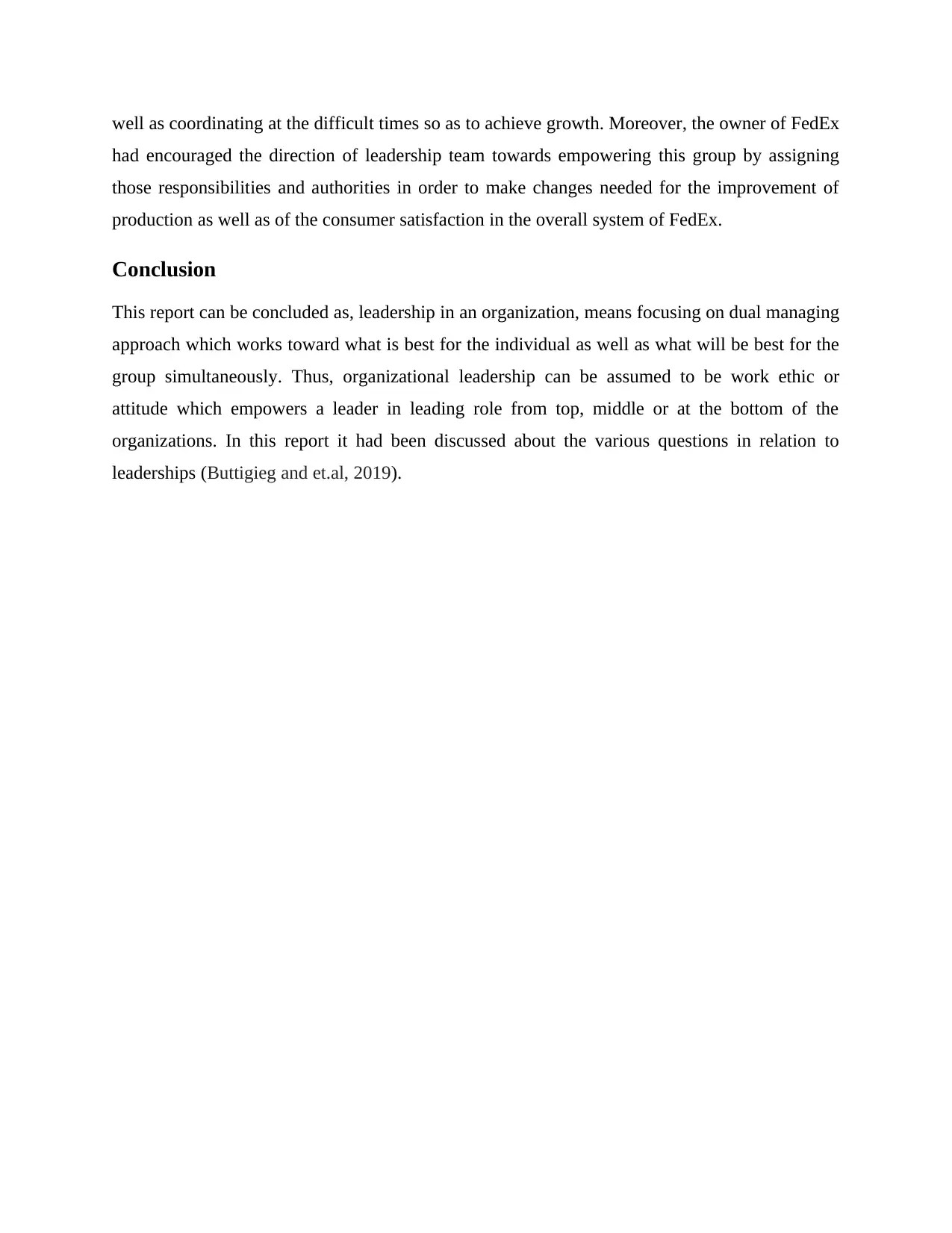
well as coordinating at the difficult times so as to achieve growth. Moreover, the owner of FedEx
had encouraged the direction of leadership team towards empowering this group by assigning
those responsibilities and authorities in order to make changes needed for the improvement of
production as well as of the consumer satisfaction in the overall system of FedEx.
Conclusion
This report can be concluded as, leadership in an organization, means focusing on dual managing
approach which works toward what is best for the individual as well as what will be best for the
group simultaneously. Thus, organizational leadership can be assumed to be work ethic or
attitude which empowers a leader in leading role from top, middle or at the bottom of the
organizations. In this report it had been discussed about the various questions in relation to
leaderships (Buttigieg and et.al, 2019).
had encouraged the direction of leadership team towards empowering this group by assigning
those responsibilities and authorities in order to make changes needed for the improvement of
production as well as of the consumer satisfaction in the overall system of FedEx.
Conclusion
This report can be concluded as, leadership in an organization, means focusing on dual managing
approach which works toward what is best for the individual as well as what will be best for the
group simultaneously. Thus, organizational leadership can be assumed to be work ethic or
attitude which empowers a leader in leading role from top, middle or at the bottom of the
organizations. In this report it had been discussed about the various questions in relation to
leaderships (Buttigieg and et.al, 2019).
⊘ This is a preview!⊘
Do you want full access?
Subscribe today to unlock all pages.

Trusted by 1+ million students worldwide
1 out of 13
Related Documents
Your All-in-One AI-Powered Toolkit for Academic Success.
+13062052269
info@desklib.com
Available 24*7 on WhatsApp / Email
![[object Object]](/_next/static/media/star-bottom.7253800d.svg)
Unlock your academic potential
Copyright © 2020–2025 A2Z Services. All Rights Reserved. Developed and managed by ZUCOL.




